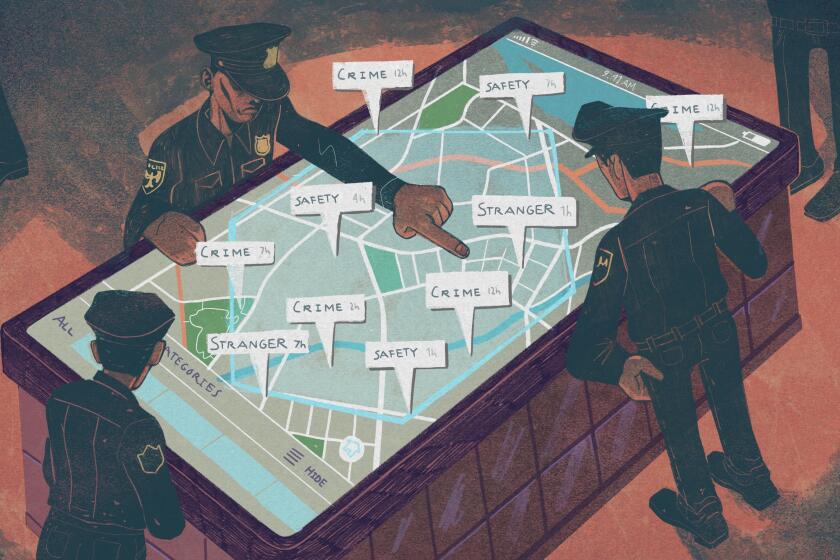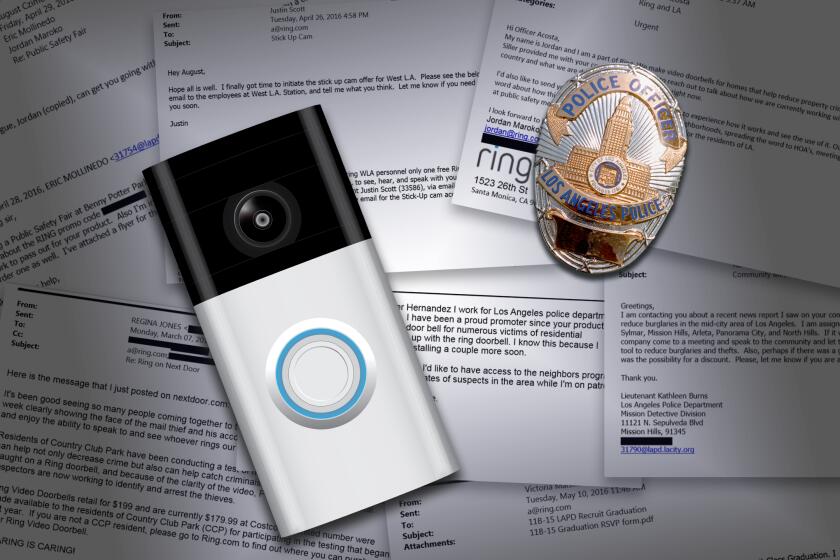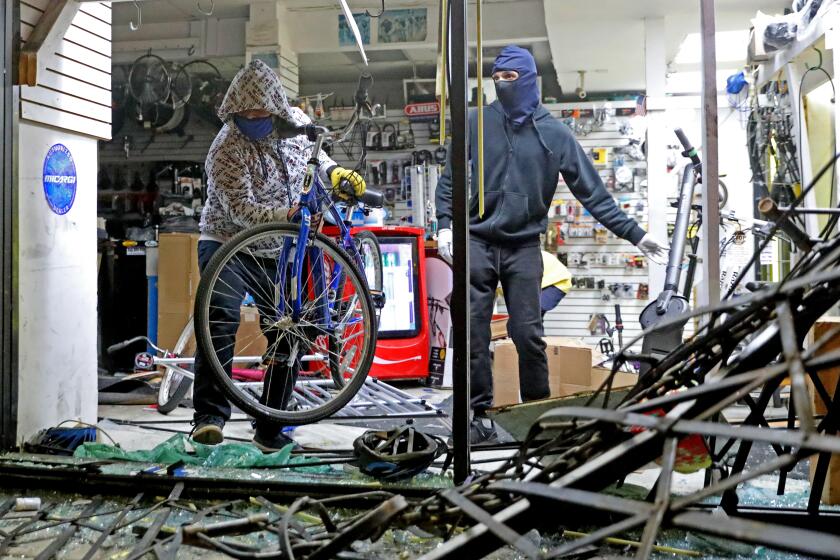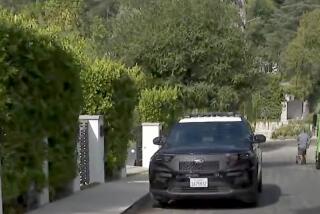Cameras, cops and paranoia: How Amazon’s surveillance network alters L.A. neighborhoods

- Share via
Ed Dorini’s house sits at the end of a cul-de-sac that snakes its way up a hill in the Sun Valley area, one of Los Angeles’ northernmost corners. It’s a small enclave whose residents are a little whiter and a little wealthier than the rest of Los Angeles. In this neighborhood, “people take care of their properties,” Dorini said in an interview in his home in late May.
Dorini, 64, came to L.A. as an immigrant from Canada in the early 1980s when he “literally had nothing” and built a business in real estate. The home he owns is one he earned with hard work, which includes remodeling parts of the house himself. He’s proud of it, and he’s intent on keeping it safe: Three years ago, he installed 10 Ring cameras to monitor his property and its various entrances.
“Everybody here has guns and dogs. People aren’t afraid to use them, and I think that’s probably a deterrent,” he told the Markup. “And cameras are, too.”
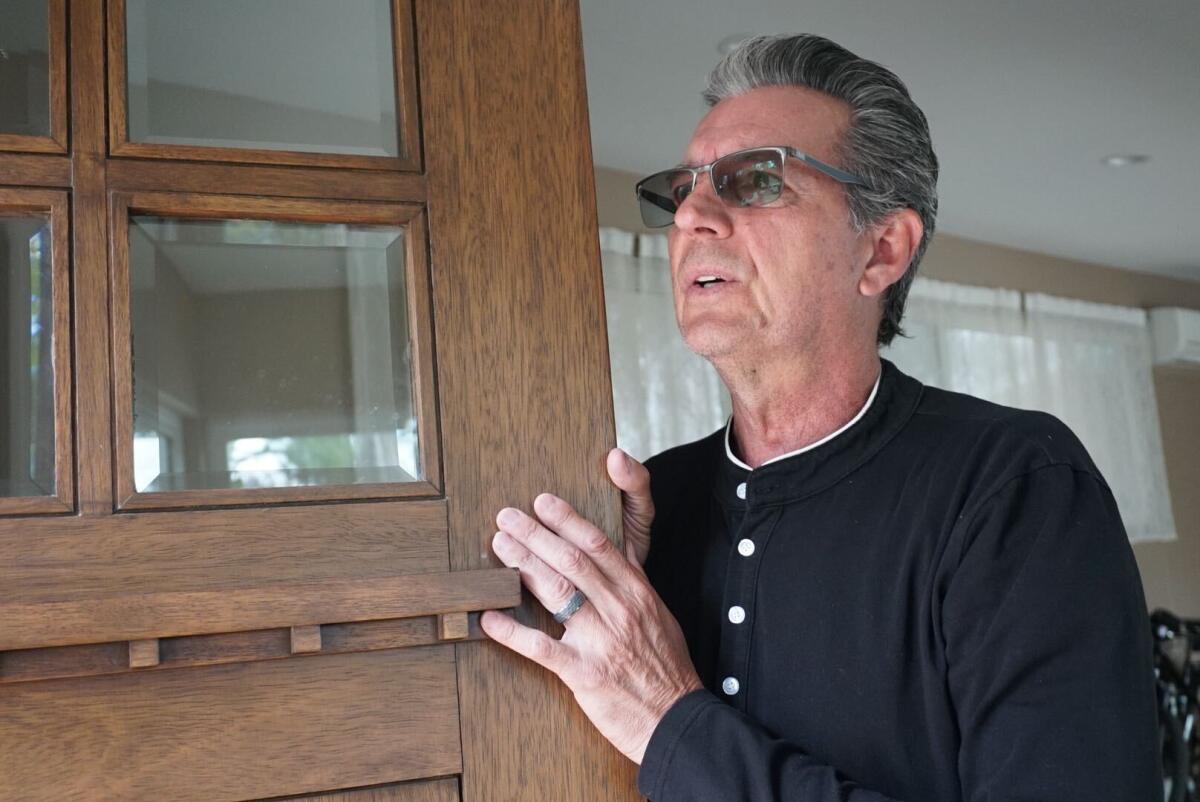
At times, he’s also found Ring’s companion app, Neighbors, useful. Both Neighbors and Ring are owned by Amazon, and the former is a social platform where Ring doorbell users — and people who join the app independently — can publish posts and footage about things happening in their neighborhood, such as theft or missing pets.
In February 2022, Dorini wrote two posts with accompanying videos about what he considered a safety issue: “Illegal dumping onto [name of street redacted] drive. Anyone recognize this truck.” Ten minutes later, he wrote: “Anyone recently have a bathroom demoed by someone with this big dump truck. Call me.”
This article was co-published with The Markup, a nonprofit, investigative newsroom that challenges technology to serve the public good. Sign up for its newsletters here.
Both of these posts landed in the inbox of 15 officers with the Los Angeles Police Department who had opted in to receive crime alerts posted on Neighbors. Dorini’s post was one of more than 13,000 Neighbors posts published by Angelenos that were automatically forwarded to LAPD officers, detectives and sergeants in just over two years, according to email correspondences that the Markup received via public records requests.
Neighbors has built a forum in which private citizens can monitor one another in service of keeping neighborhoods “safe,” as the company puts it.
That raises important questions: Safe for whom, and from what? While homeowners may believe their cameras and posts are preventing break-ins and theft, some research has shown that surveillance is a poor deterrent of such property crimes. And by trusting their cameras to keep watch for them, users render themselves blind to the ways in which community surveillance breeds paranoia, perpetuates prejudice and puts people at heightened risk of police or vigilante violence.
In the United States, where police disproportionately kill, harm and jail Black, Latino and Indigenous people at a higher rate than white people, this translates into an additional risk to people of color. That is particularly true when, as the Markup’s analysis of Neighbors posts in L.A. and research from other academics has found, its most active users live in whiter, more affluent areas.
Neighbors is “a continuation of a long history of communities coming together and creating their own surveillance systems that shape who they believe belongs somewhere and who doesn’t belong somewhere,” said Ángel Díaz, visiting assistant professor at USC Gould Law School. “And that is something that we have enshrined not only through law enforcement, but through laws around disorderly conduct and things like that.”
The Markup worked with students from the NYCity News Service at the Craig Newmark Graduate School of Journalism at City University of New York to perform the public records requests (full disclosure: Craig Newmark is also a funder of the Markup).
Our analysis of a random sample of Neighbors posts found that more than 30% of the posts the LAPD received did not describe criminal activity, even if users classified them as “crime.” The content of these posts often included behavior residents deemed suspicious, such as someone “checking cars.” According to emails between Neighbors employees and the LAPD, only posts classified as “crime” were supposed to be forwarded to officers — but this did not always happen. Dorini, for example, classified his posts that landed in officers’ inboxes under “safety.”
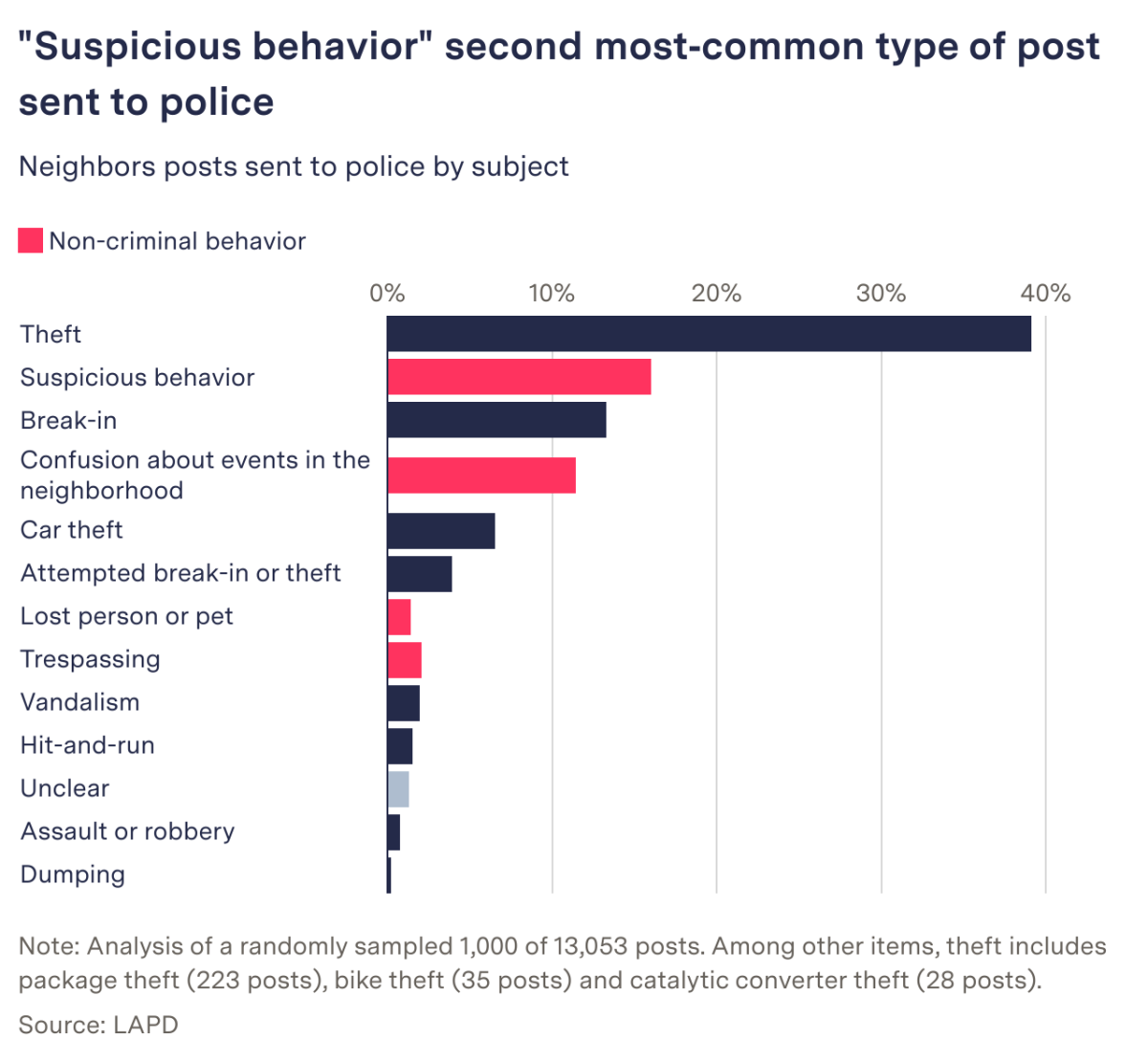
“Reports of suspicious behavior are coded ways of saying someone does not belong, which in many affluent areas correlates with targeting people of a different race,” Andrew Guthrie Ferguson, a professor of law at American University and author of “The Rise of Big Data Policing: Surveillance, Race, and the Future of Law Enforcement,” said in an email.
“In affluent communities that rely on police to keep out ‘the other,’ they will feel more comfortable reporting the suspicion,” Ferguson said. “In less affluent communities that have more complex relationship[s] with the police, the decision to report suspicion will be more circumspect.”
As of September, 2,604 police departments across the United States have forged partnerships similar to LAPD’s with Amazon’s Ring network. In addition to that, 589 fire departments and 66 local government agencies have also signed on. It’s part of a marketing strategy at Ring that targets not just retail customers but also law enforcement agencies, without always making the relationship between police and Ring fully clear to its consumers.
The Markup reached out to 24 consumers whose posts were forwarded to LAPD officers, and three people responded. None were aware that their information had been subject to police monitoring, though they had differing perspectives on the role of law enforcement.
One person, Lenin, who did not want to give his last name, was surprised and said it was “not cool” that LAPD was receiving these alerts.
The majority of people interviewed, however, were unfazed.
“Honestly, I don’t really care either way, you know,” said Dorini’s neighbor, Juan Longfellow. “Everyone has cameras. So, I mean, it’s kind of everywhere. ... I’m not one of those people who’s afraid for my privacy or whatever.”
When the Markup told Dorini about Neighbors sending posts to police, he was delighted.
“I like it,” he said. “If [police] got thousands of other ears and eyes out there, [helping] them get involved with, you know, dealing with issues — well, for me, that’s a good thing.”
Ring‘s policy is not to hand over footage from consumer doorbell cameras to authorities unless they have a warrant or there’s a life-threatening situation. Ring spokesperson Mai Nguyen said that posts on Neighbors do not reveal the addresses of users or the Ring device’s owner. Footage and information posted on Neighbors, however, are allowed to be shared, according to the terms of service.
Los Angeles police officers can receive dozens of emails per day from Neighbors, a social network for owners of Amazon Ring cameras. What are they doing with all that data?
Moreover, although Ring refers to its programs with police departments as “partnerships,” the LAPD’s spokesperson doesn’t see it as one.
“We do not work specifically with RING. We work with citizens, or whoever has a RING system, as part of a crime investigation,” wrote Officer Drake Madison in an email response to a query from the Markup. “Video surveillance is a great tool. Unfortunately, we will not be speaking on the RING system at this time,” he added in a final email.
‘A neighborhood thing’
In its ethnic and economic makeup, Dorini’s neighborhood is typical of those where Ring camera users tend to be concentrated. Walking in the neighborhood, security systems are prevalent — half of the two dozen homes on Dorini’s block have visible cameras.
Even though crime rates ticked up between 2018 and 2022 in Los Angeles, they were still well below levels in the 1990s, and the crime rates in Dorini’s area and adjacent neighborhoods remained the same or decreased between 2018 and 2022, according to a USA Today analysis of data collected by the nonprofit Crosstown.
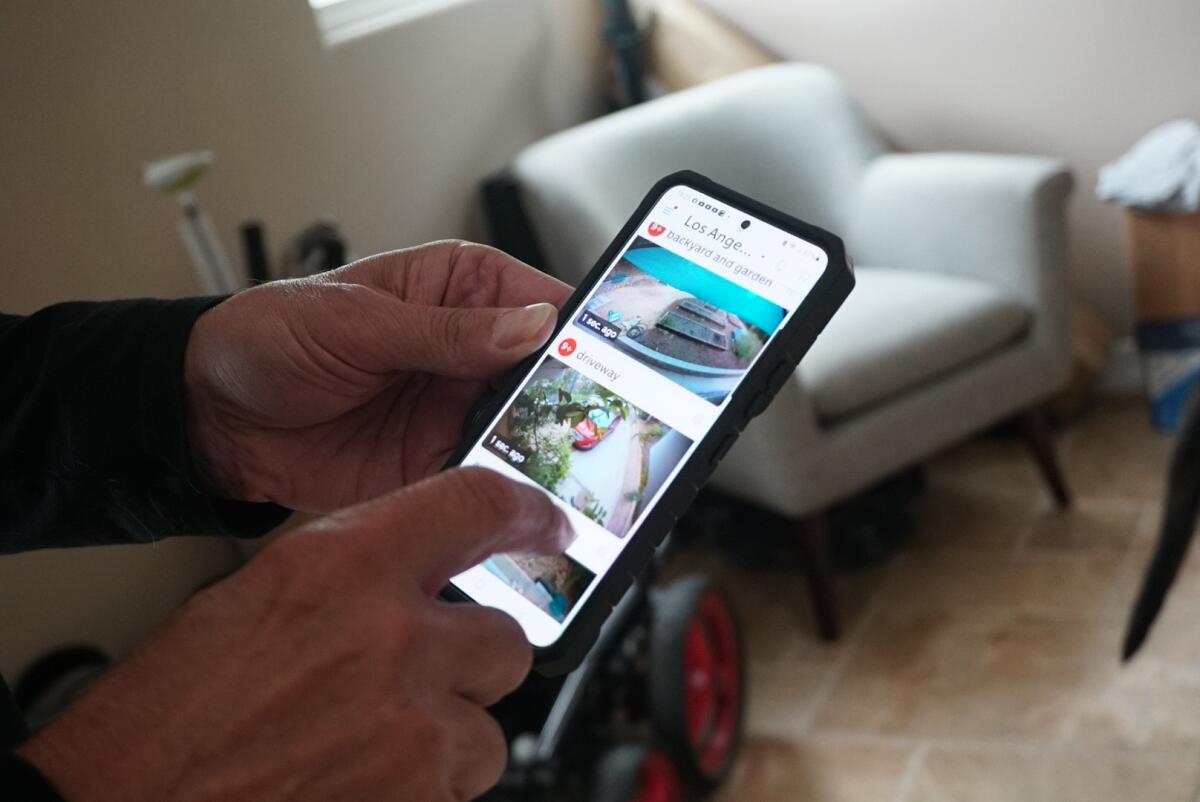
The Markup analyzed the connection between income and Ring camera usage using a database of Neighbors posts from 2018 to 2020 that Princeton researcher Dan Calacci shared with the Markup. The Markup narrowed down the database, which consists of nearly 875,000 posts, to only Neighbors posts located in 25 of the biggest cities in the U.S. where Ring partnered with the police, and found that Los Angeles was among four cities where users in neighborhoods with higher income levels tended to post more often.
When the Markup further analyzed Neighbors posts published in 2019 in Los Angeles, an even clearer trend emerged: Richer areas of the city posted roughly six times more on Neighbors than poorer areas.
Much of what Dorini and his wife would see on their Ring footage was wildlife — cheeky coyotes crawling through backyards or deer trotting along — but it was also a way to keep an eye on the property and keep people from “monkeying around our house.” As he scrolled through the Ring app, it displayed live feed after live feed of the spaces around him.
Being a Ring owner gave him a different benefit, too, he said. “We didn’t really realize that it was going to have a network situation. [...] We noticed that it started to become like a neighborhood thing.”
The neighbors on this block all know one another, and they will often work together to ensure their homes are safe, Dorini said. Once, he said, he and his neighbors used their security camera footage to help police track down an alleged burglar who had walked through their backyards. Dorini said he was unaware of whether the person was accused of stealing in their neighborhood.
Ring provided at least 100 LAPD officers with free devices or discounts and encouraged them to endorse and recommend its doorbell and security cameras to police and members of the public.
Elsewhere in the Sun Valley area, one person wrote a post in 2018 — which was categorized as “suspicious” — about a “Hispanic man with sleeping bag.” “Male Hispanic in his 20’s with a sleeping bag was hanging out by our driveway,” the post read. “Asked him to leave twice and he said he had been hiking and said he used sleeping bag to sit on his hike. We told him to leave as he doesn’t belong here and he got very annoyed, and a neighbor followed him down the street. Please be careful!”
In response to questions from the Markup, Ring spokesperson Nguyen offered a statement providing an overview of Ring’s work with police and its content moderation policies.
“Ring does not tolerate racial profiling and hateful content when it comes to content on Neighbors,” Nguyen said. “We’ve invested many resources to help us deliver on this commitment — Neighbors has strict community guidelines, trained moderators, user flagging capabilities, and other tools in place to help create a safe place for all members of the community. We prompt users to review their posts for potential bias before submitting to Neighbors, and all content submitted to our app is reviewed before it’s published to help ensure it adheres to our community guidelines.”
Ring updated its guidelines in 2021 to require community members to publish posts based on actions they’ve observed or recorded, rather than on suspicions. On the website it said that “Neighbors acknowledges that posts reporting concerns about an individual can be influenced by implicit bias and profiling — even if unintentional.” It is unclear how much of an effort Ring has made to ensure that people follow these guidelines.
“The paranoia of somebody’s imagination is making its way into that of other people,” said Díaz, the visiting law professor at USC, about neighborhood platforms like Neighbors. “And so, if you’re just passively keeping up with alerts and read them and move on with your day, you get inundated with this fear that your neighborhood is very unsafe, based on unsubstantiated accusations that are oftentimes more reflective of people’s own prejudices than anything else.”
Calacci’s analysis of his own database of Neighbors posts found that people who are homeowners and live in white “enclaves” (white neighborhoods surrounded by other white neighborhoods) are more likely to post on the platform. His analysis also showed that majority-white neighborhoods that tend to call 311 to sweep homeless encampments also post more on the Neighbors platform.
“Such calls bear the closest resemblance to the notion of neighborhood gatekeeping — they literally entail policing presence and belonging in a neighborhood,” Calacci wrote in his paper, which was published last year.
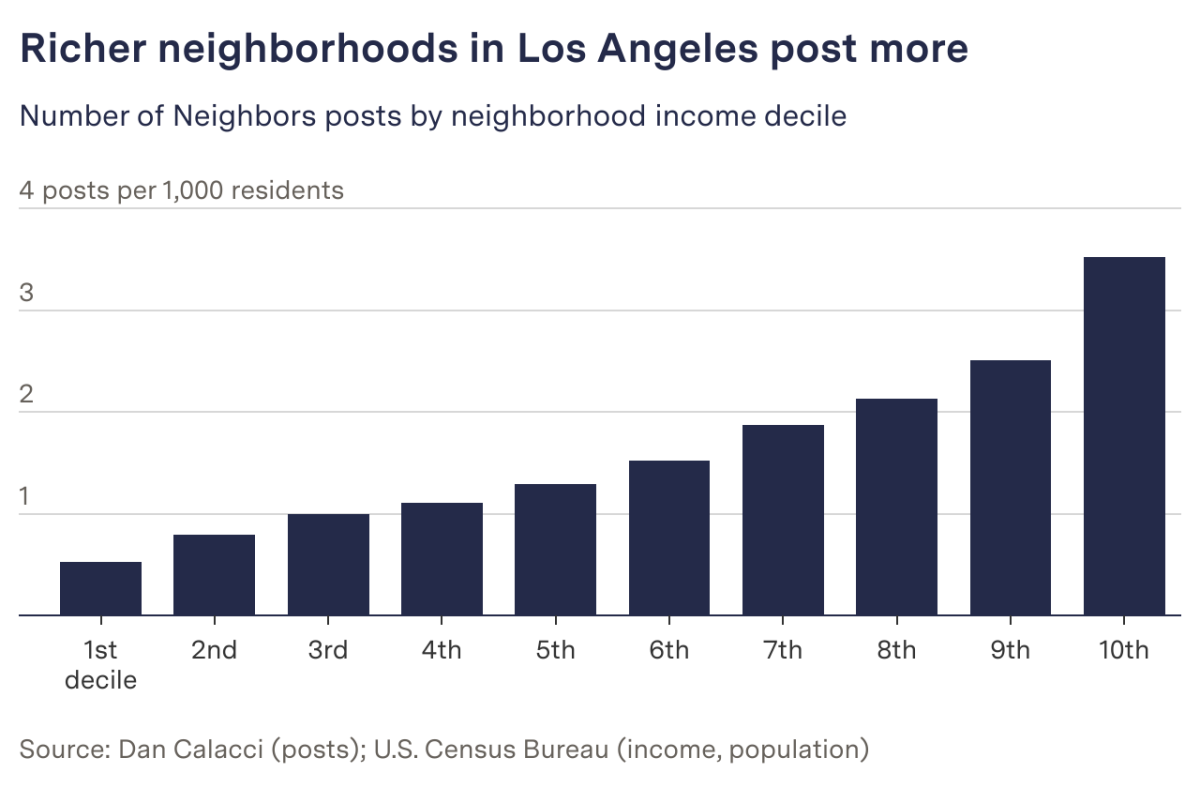
In 2021, the Stop LAPD Spying Coalition audited the Police Department’s Suspicious Activity Reporting (SAR) program, in which community members were encouraged to report suspicious activities to help officers prevent terrorism attacks. The coalition’s analysis showed that close to 60% of reports were filed in communities that were predominantly white, and that roughly half of them were deemed unfounded.
Hamid Khan, the coalition’s founder, said programs like SAR show that police will often hear from anonymous voices from largely white neighborhoods. Technology like Neighbors’ email alerts to LAPD just streamlines this process, “so that’s where the license for racial profiling comes in,” he said.
No choice but to move
Drive south from Dorini’s home for about an hour — down to near Broadway and 92nd Street — and you’ll find yourself where Ernie Arzu lived when a Neighbors post he wrote about a friend’s missing dog got forwarded to the LAPD.
His post about a Yorkshire Terrier named Bella Dior was like many others in his neighborhood: Missing animals posts made up about half of the 12 Neighbors posts the Markup was able to identify in Calacci’s database to be from his area. The neighborhood is 77% Latino and 19% Black; by comparison, Dorini’s is 64% white, 20% Latino, 12% Asian and 2% Black.
Only one post from Arzu’s area of South Los Angeles was categorized as suspicious behavior.
Arzu had bought a Ring camera, largely to keep an eye on his 15-year-old daughter who he said “sometimes likes to sneak out,” but doesn’t check in on the footage all that much.
Arzu is a Black personal trainer and caretaker, whose family is originally from Belize. He’s lived in the city since 1986, when he moved there as a 10-year-old.
“I’ve been in L.A. for as long as I can remember,” he said.
The crime rate in his neighborhood is 93 crimes per 1,000 residents, compared with the citywide average of 60 per 1,000 residents. But despite people who live in the area experiencing more crime than the average Angeleno, Arzu said that LAPD would rarely help.
LAPD detectives investigating crimes that occurred during last summer’s George Floyd protests sought out video footage from private residents who own Amazon Ring cameras, according to partially redacted police emails obtained through a public records request.
The only time Arzu called the police when he was living there was when he saw “young kids” vandalize a neighbor’s home. The police did not arrive at the scene until five hours after the call, he said. Arzu was doing yard work in his front yard when the officers arrived. Instead of looking for the teens who had destroyed his neighbor’s property, Arzu said, they asked him for his ID, assuming he did not live at his residence.
“[The LAPD] don’t really mess with us. There’s nothing positive. And it’s nothing negative,” he said.
Past research has shown that Black people experience more violence and harassment from police, as well as harsher policing strategies, than their white counterparts. Tufts University Assistant Sociology Professor Daanika Gordon describes how in more affluent, white neighborhoods, police act as “responsive service providers” while Black populations are simultaneously oversurveilled and socially controlled — not to mention neglected and underpoliced when it comes to emergency services.
But the lack of help also had a different effect: Arzu’s wife would obsess over crime on Neighbors. She felt unsafe in the neighborhood, so Arzu and his family recently decided there was no other recourse than to move away.
“My wife wants to move. She [doesn’t] like the neighborhood. There’s crime,” he said. “I don’t see no crime, but apparently there is. Then you know, it’s just a little quiet neighborhood to me.”
NYCity News Service writers Randi Love, James O’Donnell, Ariana Perez-Castells, Natalia Sánchez Loayza and Paisley Trent contributed to this report.
This series was made possible through support from the Pulitzer Center’s AI Accountability Network.
